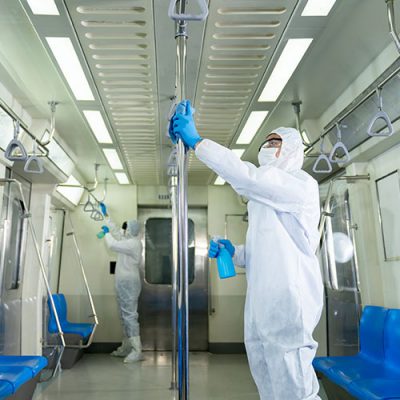DISINFECTION
DISINFECTION
The most common fields of application:
- Intensive livestock
- Hatcheries
- Food Industries
- Public Hygiene
- Warehouses
- Greenhouses
- Public and Commercial Transports
- Catering Trade
- Hotels
- Schools

DISINFECTION IN FOOD INDUSTRIES
Food industry, particularly in dairy farming, meat and deep-freeze industry, as well as the agriculture and the pharmaceutical cosmetic industry, applies fogging for disinfection, especially air disinfection.
IGEBA ULV aerosol generators are very suitable by their specific characteristics, which increase efficiency of suitable disinfectants favourably.
FIELDS OF APPLICATIONS
- Beverage industry
- Fish Farms
- Meat industry
- Milk industry
- Mills and Cereal Production
- Mushroom production

DISINFECTION IN INTENSIVE LIVESTOCK
There are different sorts of micro-organisms in stables of productive lifestock. Under certain circumstances, mostly viruses, fungus, bacteria as well as parasitic spores cause diseases. Even otherwise innocuous germs can increase considerably in unfavourable husbandry and lead to so-called “factitive diseases”. Also the climate in stables in connexion with certain conditions in relation with husbandry and feed may cause permanent stress for the animals. This stress does not appear as visible disease, though, but leads to loss of efficacy and is generally called “hospitalism”.
To secure productivity, it is indispensable to avoid an increase of the number of germs by methodical hygiene. The precondition is hygiene management that is especially tuned to the species. Besides thorough cleaning and careful disinfection, the aim is to keep the obtained hygienic condition while the stable is occupied. There might be always an increase in the number of germs by new flock of animals, excrements, feed, personnel, visitors and vermin (flies, beetles, rodents). To prevent this, regular disinfection in partly emptied stable units is necessary. It is very important to combat different types of pathogens (viruses, bacteria, fungus) by targeted application at the same time.
For a permanent result, not only all areas have to be treated evenly, but also the air has to be disinfected with appropriate active agents. Using fogging, where liquids are fragmented into micron droplets, the whole location can be filled up easily with disinfection solution. Even places that are difficult to access, e.g. ventilation ducts, cracks or gaps can be reached. Because of the fog staying airborne in the room without draining off, the active agent develops its maximum efficacy. At the same time, this method is splendidly applicable for disinfecting of the compartment air.

WATER BASED SOLUTIONS
Fogging of water-based solutions differ from oil formulation regarding droplet spectrum. Fogging of aqueous solutions produces a wet fog, whose droplets are clearly larger than 10 microns VMD ( = volume median diameter).That means that the droplet spectrum is larger compared to the droplet size of oil based solutions. Fog of water-based solutions, virtually is less visible, however has no influence on the efficacy. Finer droplets can be achieved using smaller dosage nozzles whereby the output quantity is reduced likewise.
Using IGEBA thermal fog generators, the portion of small droplets in a wider spectrum of droplets of the humid fog can be increased by operating with a special fog tube. Furthermore, the addition of special carriers, such as IGEBA NEBOL optimizes the droplet spectrum and has a positive effect on the ability of floating, consistency and visibility of the droplets.
Disinfection made of organic acids make special demands on the application technique. IGEBA fog generators are, therefore, also available in acid-proof design.
PROCEDURE OF A SYSTEMIC HYGIENE IN LIVESTOCK
Thorough cleaning
Each contamination lowers the efficacy of the applied disinfectants considerably. Therefore, it is necessary to clean thoroughly all stable areas (walls, ceiling, floor, ventilation systems, devices and stable equipment) before every disinfection measurement. Mind the water-insoluble grease films on the surfaces! These grease films lead to a bad cleaning effect by bonding both filth and germs, and therefore, they lead to a loss of efficacy of the following disinfection. Soak all stable areas by using, for example, a high pressure cleaner; spray the surfaces with cleaning solution, allow to react and clean all areas with a high pressure cleaner.
Successful disinfection

Fogging with a disinfectant should be the main element of a substantial disinfection programme, which follows thorough stable cleaning. After cleaning all openings (incl. ventilation shafts) have to be well sealed, thereby the dense fog can fill the whole space. Ambient conditions should not differ too far from a temperature of 25°C and relative air humidity of 75% as this is ideal for the distribution of the droplets.
Treatment of the stable is carried out by a suitable opening at the front of the building (depending on the local facilities). You should use a small nozzle for fogging of the solution as well as to avoid big droplets that rather settle as wet condenstation on the floor close to the fog generator. This application demands more time, but is appropriate. Pay attention to the operator not using bigger nozzles to shorten time of output.
Use disinfectant safely! Always read identification and product information before use!
PUBLIC HYGIENE
Everywhere humans are gathering, always different germs clash together. Every human carries germs, which can be transmitted in different ways, i.e. droplet infection/contact infection. Generally this does not represent a special risk for healthy persons. If health is already weak due to other influences or if it concerns older persons and/or children, even an actual harmless infection can cause severe health impairments. Thereby heavy infections can spread extremely rapid. More and more epidemic or pandemic diseases are reported in media, i.e. caused by different influenza – SARS or the Bird Flu.
Thus an effective hygiene management gets more and more important in all ranges, in which increased infection risk exists. These are places where every day, many people come together i.e. public transports, food processing and handling (restaurants, large-scale catering facilities, etc.) and the places, where particularly jeopardized category of persons stay (hospitals, homes for the old people, schools/kindergartens, etc.).
The kind of disinfection depends on the way of infection of the pathogenic agent which has to be controlled.
Whereas pathogenic agents spreading by contact of infected persons and/or contaminated surfaces (contact infection) usually can be controlled by thorough disinfection of the hands and surfaces. But those spread over the air (droplet infection) or particularly in sensitive areas, i.e. surgery a large-scale treatment is necessary. Fogging technology offers an effective possibility, both, air- and surface disinfection. Hereby the liquid is divided into minute droplets and fills up the whole space with disinfection solution. Even difficulty accessible areas will be reached. The active agent unfolds its maximum effect, since the fog remains airborne over a long time and falls down slowly. Depending upon the space conditions and kind of the disinfectant used, IGEBA cold fog generators, i.e. Nebulo and Thermal Fog Generators, i.e. the IGEBA TF 35 can be applied.
Water-Based Solutions
Fogging of water-based solutions differ from oil formulations regarding droplet spectrum. Fogging of aqueous solutions produces a wet fog, whose droplets are clearly larger than VMD 10 microns. (VMD = Volume Median Diameter).That means that the droplet spectrum is larger compared to the droplet size of oil based solutions. Fog of water-based solutions, virtually is less visible, however has no influence on the efficacy. Finer droplets can be achieved using smaller dosage nozzles whereby the output quantity is reduced likewise.
IGEBA offers for Thermal Fog Generators special fog tubes for water as carrier. The special fog tube improves substantially droplet spectrum of water-based solutions. Addition of carrier, i.e. IGEBA NEBOL improves droplet spectrum additionally and droplets remain airborne for longer time. The visibility of the fog is increased, too.
The application of disinfectants from organic acids requires special application technology. IGEBA Fog Generators are available in acid resistant execution.


 CHEMICALS
CHEMICALS